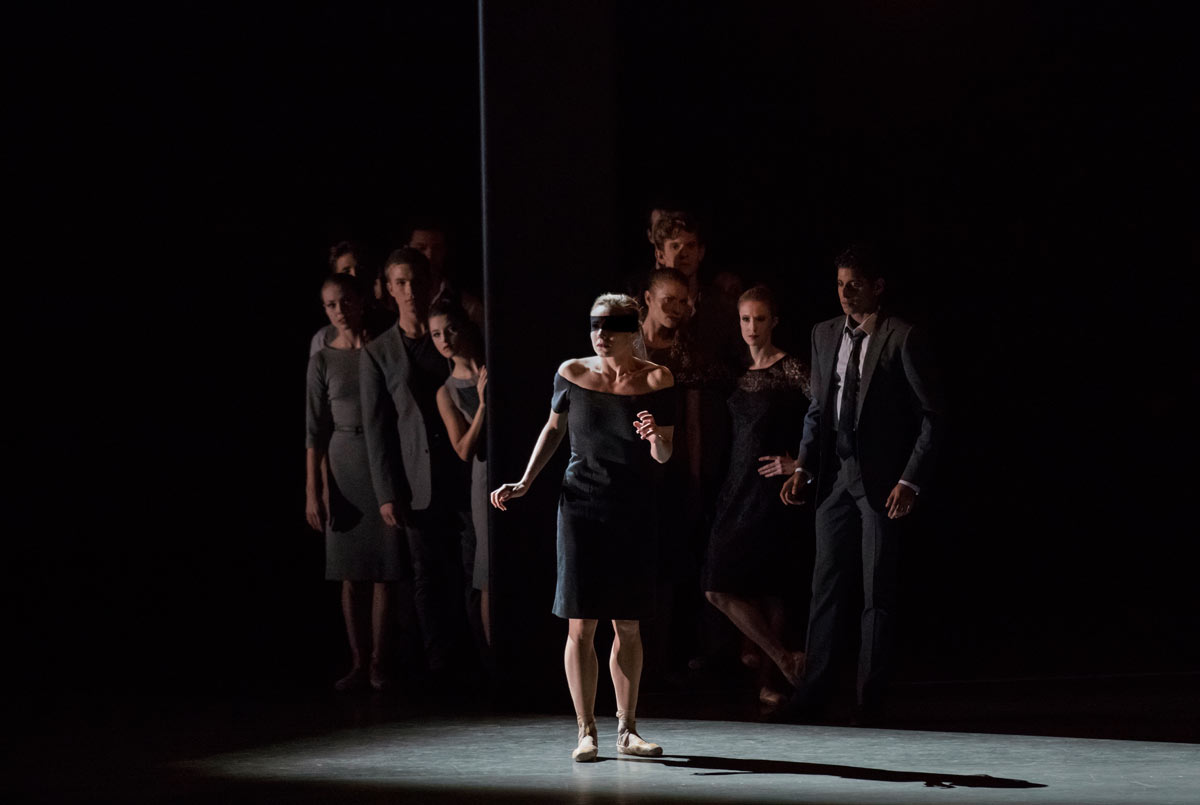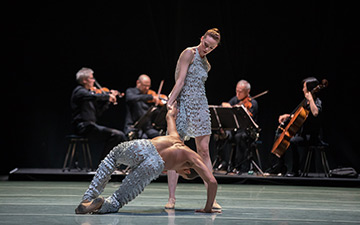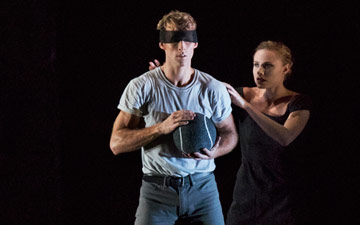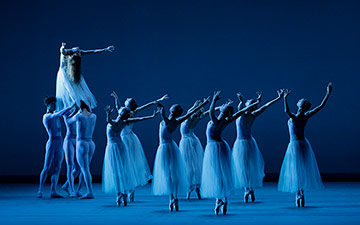
© Paul Kolnik. (Click image for larger version)
New York City Ballet
Polaris, The Blue Distance, Common Ground, New Blood, Jeux
New York, David H. Koch Theater
8 October 2015
www.nycballet.com
Ballet Noir
To a program of four new ballets commissioned for its fall gala (Sept. 30), New York City Ballet has now added a fifth new work, by the London-based Danish choreographer Kim Brandstrup. (It replaced the night-club-themed Thou Swell, by Peter Martins, on the second half of the program.) The première took place on the evening of Oct. 8.
As Roslyn Sulcas detailed recently in the Times, Brandstrup is a completely different breed of choreographer from the other four, all of whom are products of the somewhat closed ballet world and still in their twenties. To begin with, he’s fifty-eight; he didn’t even start dancing until his twenties; he began in modern dance and he has a background in film. Not surprising, then, that his piece, Jeux, has a distinctly adult atmosphere and a highly cinematic look. Actually, the look might be the most interesting thing about it.
Unlike the other ballets, which had costumes designed by luminaries from the fashion sphere, Jeux was costumed by the company’s in-house costume director, Marc Happel. And, perhaps not surprisingly, these were by far the most effective costumes of the lot. A variation on tailored streetwear, the gray (or black) below-the-knee dresses and suits would not have looked out of place in an Alfred Hitchcock movie. The two principal women, Sara Mearns and Sterling Hyltin, wore black; their dresses had a very flattering line with a slight ruffle at the back and open necklines revealing the clavicle and the line of the the shoulders, a particularly beautiful part of the dancer’s physique. Tights and toe shoes were a natural color. The dancers were meant to look like women, not ballerinas.

© Paul Kolnik. (Click image for larger version)
The atmosphere was like something out of a film noir. A light bulb dangled from a long wire, creating a circle of light on an otherwise murky stage. A column divided the space in two, creating a crowded room on the right side and a larger expanse on the left. At times, the column also provided something for the characters to hide behind and peer out at the others. Halfway through the ballet, a black back curtain rose to reveal a dark spot in the sky, and later a pulsating light.
As the ballet began, a man (Amar Ramasar) blindfolded a woman (Sara Mearns) who spent a good portion of the ballet wandering around the stage in a never-ending game of blind man’s bluff. She piquéd and fell, piquéd and fell, reaching before her for some human contact. The others stayed just out of reach. The crowd eventually sorted itself into a series of couples, who came and went as Debussy’s score – originally composed for the Russian choreographer Vaslav Nijinsky – swirled and billowed around them.
Mearns was eventually approached by a younger man (Adrian Danchig-Waring). I say younger because he was dressed more casually than the others and held a ball, perhaps an allusion to Nijinsky’s ballet, which took place during a round of tennis. She was still blindfolded; he ducked under her leg as she lifted it in massive ronds de jambe. She spun slowly in arabesque and he lifted her into the air, still reaching into space.

© Paul Kolnik. (Click image for larger version)
A second couple appeared – Amar Ramasar and Sterling Hyltin – and engaged in a more tender, waltzy pas de deux, echoed by the other couples. At this point the ballet started to feel a little woozy, with echoes of Balanchine’s La Valse. A black sun appeared in the sky. Mearns returned, eyes now uncovered; at first she danced with the young man, meltingly, then, in a fit of anger, grabbed Ramasar and forced him into a dance. The two women, Mearns and Hyltin, fought for his attention.
All of this may sound more interesting than it actually was. The truth is that for all its cinematic style, Jeux lacks dramatic tension. Despite echoes of La Valse, its pulse never quickens; the stakes remain frustratingly low. We never wonder or care who these people are, or why this woman has been singled out for torment. Why is she blindfolded? What are the other characters’ intentions? Jeux feels like the germ of an idea, never fully developed, a scenario without a clear point of view. Nevertheless, it’s handsome to look at, the music is beautiful and mysterious, and the dancers make the best of it.

© Paul Kolnik. (Click image for larger version)
This is true of the whole evening, really. The dancers look fabulous – energized, musical, strong, fast, fearless. The four short works – by Myles Thatcher, Robert Binet, Troy Schumacher, and Justin Peck – look as well-crafted as before, but don’t reveal new secrets on second viewing. The exception is Peck’s New Blood, which stands out as the most dazzling in its construction, momentum and precision of design. The multi-color bodysuits, by Humberto Leon, make the dancers look as if they had been dipped in black ink. Somehow, it works. The dancers are like particles, spinning into each other, separating, diving and stretching their limbs in all directions. Again, Claire Kretzschmar and Ashley Bouder make a searing impression, flashing from position to position with a daredevil air. The ballet never stops and it never blurs; even the smallest detail is etched clearly in space. It shows the City Ballet dancers at their most expansive and most daring.

















You must be logged in to post a comment.